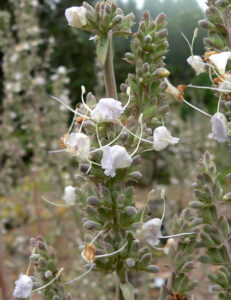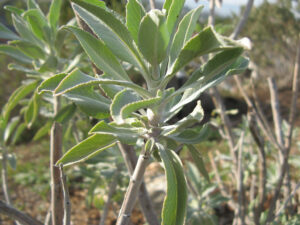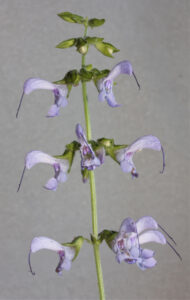
Sage insights: The expanding world of salvias
By Clive Larkman
The genus Salvia is one of the largest plant genera with over 1,000 species. It is a member of the Lamiaceae, the mint family, which includes most of our aromatic and many of our medicinal herbs. Salvia is the largest genus in the Lamiaceae and consists of annuals, perennials and evergreen shrubs that grow in full desert sun to moist woodland environments. The genus is widespread with species indigenous to every continent excepting Australia and Antarctica. Most Salvia species are native to the North and Central Americas.
Salvia is a large genus and has just had Rosmarinus and Perovskia added to it. The botanists are constantly reviewing various members of the Lamiaceae family, and I suspect it will not be long before they split Salvia into several genera. It is large and diverse.
An interesting fact about salvias is that every colour is represented in their flowers. Almost all other genera are usually missing the gene of one of the major colour groups. There is no true red lavender, no yellow rosemary, nor blue rose, blue grevillea, blue hellebore or yellow hebe.
The common name for the Salvia genus is sage, and while sage (Salvia officinalis) is a renowned culinary herb, other species in the genus also have culinary and medicinal applications. Then there is the species loved by our alternative community; Salvia divinorum (diviner’s sage or seer sage). This is a plant that has been banned in Australia and parts of the United States due to its use as a hallucinogenic drug. Another classic for that community is Salvia apiana (white sage), widely used for smoking ceremonies. Sell sage at any mainstream market and you will get at least one request for these plants.

Over the last twenty or so years, salvias have become very popular as ornamental garden plants. Their colour and size range, and ability to deal with a wide range of soils makes them great for all gardens across most of Australia. They also have wide usage in the culinary ranges of many countries. Common sage and common rosemary are regularly used in Western recipes. There are also many salvias that have medicinal uses.
One that is widely used in China and Japan is Salvia miltiorrhiza or Chinese red root sage (Chinese: dānshēn). The species name means ‘red ochre root’. This perennial shrub is highly valued for its roots in traditional Chinese medicine. Native to China and Japan, it grows from 90 to 1,200 m above sea level in grassy fields in the forests on hillsides, and along waterways. Like most salvias it requires full sun for at least four to six hours per day to flower well. It prefers well-drained soil and is moderately frost tolerant.

Chinese red root sage grows to around 60 cm tall by 50 cm wide producing mauve to lavender flowers on 30 cm stems. The flowers stems are covered with sticky hairs, and the flowers are quite fragrant. They occur in mid-spring to mid-summer and are attractive to bees due to the purple-blue colour and high fragrance. In most temperate environments, this sage is evergreen; however, in cold climates it is herbaceous and may die down over winter. The foliage is dark green with wavy edges and the occasional mauve tint.
This plant’s main attraction is the large red main root that gives it its Latin and common names. It is widely sought after in Japan and China for its medicinal properties. It has been a part of traditional Chinese medicine for many years and is used for improving blood health. The benefits are also being seen in modern Western medicine with work being done to register its extracts. Both clinical and anecdotal evidence indicate that the roots are beneficial to a range of blood conditions, as well as reducing blood pressure, improving circulation and reducing cholesterol. Like most salvias, Chinese red root sage is a true edimental being both a useful herb and an attractive flowering shrub for the cottage garden. Relatively new to cultivation, the plants are starting to appear in many online catalogues and the occasional retail nursery.
